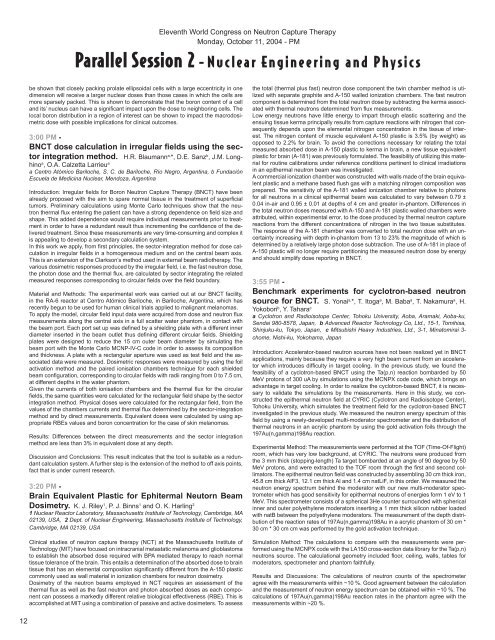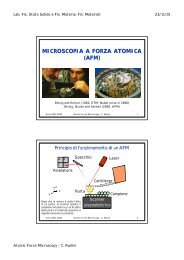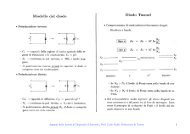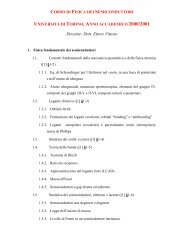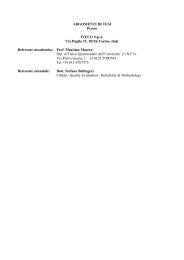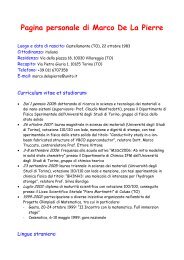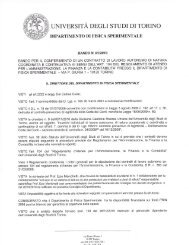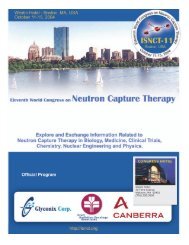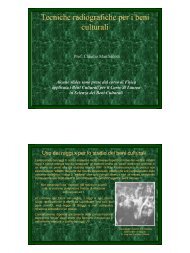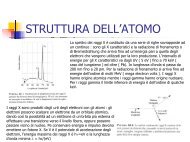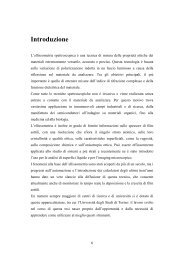Create successful ePaper yourself
Turn your PDF publications into a flip-book with our unique Google optimized e-Paper software.
Eleventh World Congress on Neutron Capture TherapyMonday, October 11, 2004 - PMParallel Session 2 - N u c l ea r E n g i n e e r i n g a n d P hy s i c sbe shown that closely packing prolate ellipsoidal cells with a large eccentricity in onedimension will receive a larger nuclear doses than those cases in which the cells aremore sparsely packed. This is shown to demonstrate that the boron content of a celland its’ nucleus can have a significant impact upon the dose to neighboring cells. Thelocal boron distribution in a region of interest can be shown to impact the macrodosimetricdose with possible implications for clinical outcomes.3:00 PM -BNCT dose calculation in irregular fields using the sectorintegration method. H.R. Blaumann a, *, D.E. Sanz b , J.M. Longhinoa , O.A. Calzetta Larrieu aa Centro Atómico Bariloche, S. C. de Bariloche, Río Negro, Argentina, b FundaciónEscuela de Medicina Nuclear, Mendoza, ArgentinaIntroduction: Irregular fields for Boron Neutron Capture Therapy (BNCT) have beenalready proposed with the aim to spare normal tissue in the treatment of superficialtumors. Preliminary calculations using Monte Carlo techniques show that the neutronthermal flux entering the patient can have a strong dependence on field size andshape. This added dependence would require individual measurements prior to treatmentin order to have a redundant result thus incrementing the confidence of the deliveredtreatment. Since these measurements are very time-consuming and complex itis appealing to develop a secondary calculation system.In this work we apply, from first principles, the sector-integration method for dose calculationin irregular fields in a homogeneous medium and on the central beam axis.This is an extension of the Clarkson’s method used in external beam radiotherapy. Thevarious dosimetric responses produced by the irregular field, i.e. the fast neutron dose,the photon dose and the thermal flux, are calculated by sector integrating the relatedmeasured responses corresponding to circular fields over the field boundary.Material and Methods: The experimental work was carried out at our BNCT facility,in the RA-6 reactor at Centro Atómico Bariloche, in Bariloche, Argentina, which hasrecently begun to be used for human clinical trials applied to malignant melanomas.To apply the model, circular field input data were acquired from dose and neutron fluxmeasurements along the central axis in a full scatter water phantom, in contact withthe beam port. Each port set up was defined by a shielding plate with a different innerdiameter inserted in the beam outlet thus defining different circular fields. Shieldingplates were designed to reduce the 15 cm outer beam diameter by simulating thebeam port with the Monte Carlo MCNP-IV-C code in order to assess its compositionand thickness. A plate with a rectangular aperture was used as test field and the associateddata were measured. Dosimetric responses were measured by using the foilactivation method and the paired ionisation chambers technique for each shieldedbeam configuration, corresponding to circular fields with radii ranging from 0 to 7.5 cm,at different depths in the water phantom.Given the currents of both ionisation chambers and the thermal flux for the circularfields, the same quantities were calculated for the rectangular field shape by the sectorintegration method. Physical doses were calculated for the rectangular field, from thevalues of the chambers currents and thermal flux determined by the sector-integrationmethod and by direct measurements. Equivalent doses were calculated by using appropriateRBEs values and boron concentration for the case of skin melanomas.Results: Differences between the direct measurements and the sector integrationmethod are less than 3% in equivalent dose at any depth.Discussion and Conclusions: This result indicates that the tool is suitable as a redundantcalculation system. A further step is the extension of the method to off axis points,fact that is under current research.3:20 PM -Brain Equivalent Plastic for Ephitermal Neutorn BeamDosimetry. K. J. Riley 1 , P. J. Binns 1 and O. K. Harling 21 Nuclear Reactor Laboratory, Massachusetts Institute of Technology, Cambridge, MA02139, USA, 2 Dept. of Nuclear Engineering, Massachusetts Institute of Technology,Cambridge, MA 02139, USAClinical studies of neutron capture therapy (NCT) at the Massachusetts Institute ofTechnology (MIT) have focused on intracranial metastatic melanoma and glioblastomato establish the absorbed dose required with BPA mediated therapy to reach normaltissue tolerance of the brain. This entails a determination of the absorbed dose to braintissue that has an elemental composition significantly different from the A-150 plasticcommonly used as wall material in ionization chambers for neutron dosimetry.Dosimetry of the neutron beams employed in NCT requires an assessment of thethermal flux as well as the fast neutron and photon absorbed doses as each componentcan possess a markedly different relative biological effectiveness (RBE). This isaccomplished at MIT using a combination of passive and active dosimeters. To assessthe total (thermal plus fast) neutron dose component the twin chamber method is utilizedwith separate graphite and A-150 walled ionization chambers. The fast neutroncomponent is determined from the total neutron dose by subtracting the kerma associatedwith thermal neutrons determined from flux measurements.Low energy neutrons have little energy to impart through elastic scattering and theensuing tissue kerma principally results from capture reactions with nitrogen that consequentlydepends upon the elemental nitrogen concentration in the tissue of interest.The nitrogen content of muscle equivalent A-150 plastic is 3.5% (by weight) asopposed to 2.2% for brain. To avoid the corrections necessary for relating the totalmeasured absorbed dose in A-150 plastic to kerma in brain, a new tissue equivalentplastic for brain (A-181) was previously formulated. The feasibility of utilizing this materialfor routine calibrations under reference conditions pertinent to clinical irradiationsin an epithermal neutron beam was investigated.A commercial ionization chamber was constructed with walls made of the brain equivalentplastic and a methane based flush gas with a matching nitrogen composition wasprepared. The sensitivity of the A-181 walled ionization chamber relative to photonsfor all neutrons in a clinical epithermal beam was calculated to vary between 0.79 ±0.04 in-air and 0.95 ± 0.01 at depths of 4 cm and greater in-phantom. Differences inthe total neutron doses measured with A-150 and A-181 plastic walled chambers wereattributed, within experimental error, to the dose produced by thermal neutron capturereactions from the different concentrations of nitrogen in the two tissue substitutes.The response of the A-181 chamber was converted to total neutron dose with an uncertaintyincreasing with depth in-phantom from 13 to 23% the magnitude of which isdetermined by a relatively large photon dose subtraction. The use of A-181 in place ofA-150 plastic will no longer require partitioning the measured neutron dose by energyand should simplify dose reporting in BNCT.3:55 PM -Benchmark experiments for cyclotron-based neutronsource for BNCT. S. Yonai a, *, T. Itoga a , M. Baba a , T. Nakamura a , H.Yokobori b , Y. Tahara ca Cyclotron and Radioisotope Center, Tohoku University, Aoba, Aramaki, Aoba-ku,Sendai 980-8578, Japan, b Advanced Reactor Technology Co, Ltd., 15-1, Tomihisa,Shinjuku-ku, Tokyo, Japan, c Mitsubishi Heavy Industries, Ltd., 3-1, Minatomirai 3-chome, Nishi-ku, Yokohama, JapanIntroduction: Accelerator-based neutron sources have not been realized yet in BNCTapplications, mainly because they require a very high beam current from an acceleratorwhich introduces difficulty in target cooling. In the previous study, we found thefeasibility of a cyclotron-based BNCT using the Ta(p,n) reaction bombarded by 50MeV protons of 300 uA by simulations using the MCNPX code code, which brings anadvantage in target cooling. In order to realize the cyclotron-based BNCT, it is necessaryto validate the simulations by the measurements. Here in this study, we constructedthe epithermal neutron field at CYRIC (Cyclotron and Radioisotope Center),Tohoku University, which simulates the treatment field for the cyclotron-based BNCTinvestigated in the previous study. We measured the neutron energy spectrum of thisfield by using a newly-developed multi-moderator spectrometer and the distribution ofthermal neutrons in an acrylic phantom by using the gold activation foils through the197Au(n,gamma)198Au reaction.Experimental Method: The measurements were performed at the TOF (Time-Of-Flight)room, which has very low background, at CYRIC. The neutrons were produced fromthe 3 mm thick (stopping-length) Ta target bombarded at an angle of 90 degree by 50MeV protons, and were extracted to the TOF room through the first and second collimators.The epithermal neutron field was constructed by assembling 30 cm thick iron,45.8 cm thick AlF3, 12.1 cm thick Al and 1.4 cm natLiF, in this order. We measured theneutron energy spectrum behind the moderator with our new multi-moderator spectrometerwhich has good sensitivity for epithermal neutrons of energies form 1 eV to 1MeV. This spectrometer consists of a spherical 3He counter surrounded with sphericalinner and outer polyethylene moderators inserting a 1 mm thick silicon rubber loadedwith natB between the polyethylene moderators. The measurement of the depth distributionof the reaction rates of 197Au(n,gamma)198Au in a acrylic phantom of 30 cm *30 cm * 30 cm cm was performed by the gold activation technique.Simulation Method: The calculations to compare with the measurements were performedusing the MCNPX code with the LA150 cross-section data library for the Ta(p,n)neutrons source. The calculational geometry included floor, ceiling, walls, tables formoderators, spectrometer and phantom faithfully.Results and Discussions: The calculations of neutron counts of the spectrometeragree with the measurements within ~10 %. Good agreement between the calculationand the measurement of neutron energy spectrum can be obtained within ~10 %. Thecalculations of 197Au(n,gamma)198Au reaction rates in the phantom agree with themeasurements within ~20 %.12


